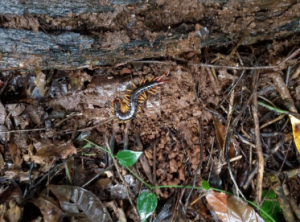CSIR - Centre for Cellular & Molecular Biology
Council of Scientific and Industrial Research
The Innovation Engine of India
Date : September 3, 2024

Hyderabad, 7th Jun, 2023: A global study led by Dr Jahnavi Joshi’s group at CSIR-Centre for Cellular and Molecular Biology (CCMB) finds that species traits such as body size and geographic factors explain over 25% of variation in genetic diversity in centipedes – a soil invertebrate group with 420 million years of evolutionary history.

Genetic diversity is a measure of differences in DNA sequences (mutations) between individuals of a species. These differences shape how they respond to environmental variability, and are known to influence species diversity. Studies determining the drivers of genetic diversity are largely limited to a few well-studied animal groups whose genetic sequence information is widely available. However, such select groups do not represent the richness of animal diversity as a whole, and scientists lack information to assess general patterns determining genetic diversity in life forms.
“To address this gap, we studied genetic diversity among centipedes, using DNA sequences and traits including body size, vision and whether or not offspring receive care, together with distribution data sourced from museum databases and published literature. Centipedes are ancient arthropods, and vary widely in species traits and biogeographic history. This along with the availability of their DNA sequences, offers a unique opportunity to investigate the correlates of genetic diversity in organisms that are not familiar laboratory models,” says Dr Joshi.
Using over 1200 sequences from a maternally inherited gene for 128 species, the study finds that genetic diversity in centipedes is higher than other arthropods such as spiders and insects. They find that genetic diversity decreases in species with larger body sizes, and is higher for species where the mother cares for offspring. It is higher in the Southern than in the Northern Hemisphere, which may be associated with historic climatic stability and low seasonality in southern latitudes. Genetic diversity increases with geographic distance between individuals, indicating a limited exchange of individuals between farther sites
“Our study finds similarities in factors determining genetic diversity with earlier studies. This
indicates that common underlying processes probably shape genetic diversity across animalgroup differing in their evolutionary histories,” says Dr Bharti Dharapuram, a postdoctoral researcher and one of the authors of the study. “This study has offered us hypotheses about the relationship between species traits and population structure that can be tested more rigorously at the regional scale of the Indian subcontinent in the future,” she adds.
Bharti, D. K., Pawar, P. Y., Edgecombe, G. D., & Joshi, J. (2023). Genetic diversity varies with species traits and latitude in predatory soil arthropods (Myriapoda: Chilopoda). Global Ecology and Biogeography.
 Advertisement no 07/10 for the post Junior Scientist.
Advertisement no 07/10 for the post Junior Scientist.
 List of shortlisted candidates for the temporary positions against CCMB Web Notif.No.0724/B- [26-08-2024]
List of shortlisted candidates for the temporary positions against CCMB Web Notif.No.0724/B- [26-08-2024]
 Result of selected candidates for the temporary positions against CCMB Web Notif.No.0724/A - [21-08-2024]
Result of selected candidates for the temporary positions against CCMB Web Notif.No.0724/A - [21-08-2024]
 Notification of Schedule for Trade Test and Downloading of Admit Cards for the posts of Gr. II (1)/Technician (1) against Advt.No:01/2021 - [19-08-2024]
Notification of Schedule for Trade Test and Downloading of Admit Cards for the posts of Gr. II (1)/Technician (1) against Advt.No:01/2021 - [19-08-2024]
 List of selected candidates for the temporary positions against CCMB Web Notif.No.0624/A - [14-08-2024]
List of selected candidates for the temporary positions against CCMB Web Notif.No.0624/A - [14-08-2024]
 List of shortlisted candidates for the temporary positions against CCMB Web Notif.No.0724/A - [02-08-2024]
List of shortlisted candidates for the temporary positions against CCMB Web Notif.No.0724/A - [02-08-2024]
 Notification No.0824/A for various temporary positions on contractual basis- [02-08-2024]
Notification No.0824/A for various temporary positions on contractual basis- [02-08-2024]
 Notification No.0724/B for various temporary positions on contractual basis - [29-07-2024]
Notification No.0724/B for various temporary positions on contractual basis - [29-07-2024]
 List of shortlisted candidates for the temporary positions against CCMB Web Notif.No.0624/A- [19-07-2024]
List of shortlisted candidates for the temporary positions against CCMB Web Notif.No.0624/A- [19-07-2024]
 List of Provisionally empanelled candidates for Engagement as Project staff Vide Notif.No.2024/1 - [15-07-2024]
List of Provisionally empanelled candidates for Engagement as Project staff Vide Notif.No.2024/1 - [15-07-2024]